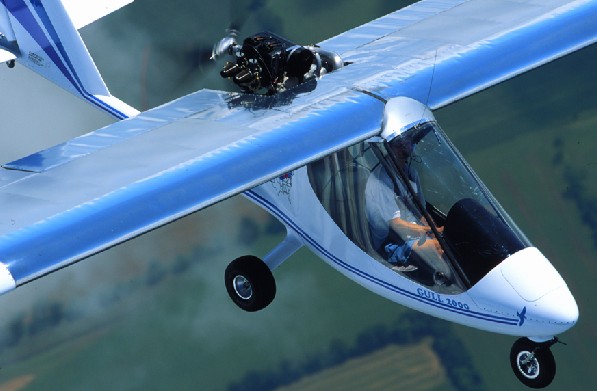
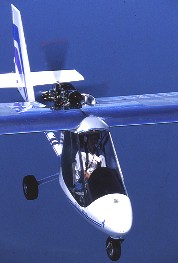
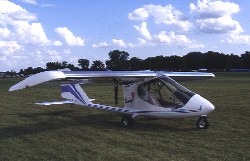
The Gull 2000, sitting very airplane-like on the ultralight/light plane runway. One of Mark Beierle’s goals in designing the Gull 2000 was to get the aircraft to sit on its nosewheel rather than recline on its tailwheel as his previous designs have done. With some ingenuity, he was able to redistribute weight to achieve that goal.
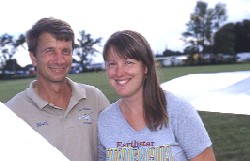
A very happy couple-Mark and Leslie Beierle. Mark has always had a nice smile, but it seems broader now that Leslie’s entered his life.

Here’s a great view of the mostly metal 20-foot wing span that’s standard on the Gull line of aircraft, although an extended version does increase the span to 28 feet. Control surfaces are fabric covered for lighter handling, and wingtips are fiberglass, but the primary wing structure is all metal.

A trademark of Mark Beierle’s aircraft is the map he always places on the side of his aircraft to keep track of where he’s flown it. Here’s where this Gull 2000 has been so far! Mark says airplanes are for flying; he doesn’t believe in trailering an aircraft to an air show.

A very wide and high door opening makes entry and exit from the aircraft very easy and comfortable. A very simple cockpit, but it has everything you need, including a rearview mirror! Adding a ballistic parachute in the nose of the aircraft was one of the ways Mark was able to get the aircraft to sit on its nose gear.
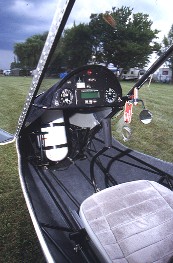

This particular Gull 2000 is the first customer aircraft in this model series to be delivered. Its owner, a Canadian gentleman, took delivery here at Oshkosh. Because Canada’s microlight regulations allow more weight, he was able to power the aircraft with a Rotax 503 engine.

Folks interested in building the Gull 2000 as a legal ultralight in the United States might choose to power the machine with a Zanzottera engine. Beierle flew the Gull 2000 powered with a Zanzottera engine to the Northwest EAA Regional Fly-In in Arlington, Washington, earlier this year where we captured these photos of the twin-cylinder version-the MZ202. If you’d like more information about the Zanzottera engines, check out their website: www.mzengines.com.
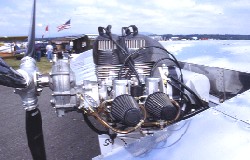
It is Mark’s design philosophy to make the most efficient aircraft he can, one that will use the least fuel. He defines himself as “a minimalist,” and this sentiment is carried throughout this beautifully optimized aircraft.
To me, Mark appears to have grown increasingly comfortable in his role within ultralight aviation. Relaxed and confident, he knows he has created a superior flying machine.
He also smiles a lot more these days in my opinion, thanks to a wonderful woman named Leslie who accompanied him to AirVenture 2000 in Oshkosh, Wisconsin. Married a year and a half ago, the two complement each other and make a good team.
No more tight squeezes
Perhaps it was this new personal relationship that motivated Mark to pay more attention to creature comforts. Notably, the Gull 2000 is wider than the previous single-seat or tandem two-seat Thunder Gull aircraft. Considering Mark is a lean and healthy vegetarian, his concern for broader pilots is no doubt appreciated.
A few enthusiasts joined my postflight discussion with Mark and Leslie while standing around the Gull 2000 on AirVenture’s ultralight strip. Among them was Chuck Slusarczyk, designer and manufacturer of the Hawk line of ultralights. Now for those of you who don’t know him, Chuck is a big boy. He once jokingly bragged that he might be the biggest ultralight manufacturer in America. The reference wasn’t necessarily to his aircraft sales numbers but more akin to his belt size. On an invitation from Mark, Chuck hopped inside the Gull 2000 and fit with room to spare. Previous Thunder Gull models were a bit tighter.
A single door on the aircraft’s left side now extends up higher and down lower to make entry and exit easier. The lower door threshold facilitates entry by allowing you to turn around, sit down, and draw your legs in after you, a preferred method of entry. Many snug aircraft require you to insert one leg first to pass around the joystick, for example. For some less able pilots such a maneuver can be tricky.
The aircraft I flew is the first being delivered to a customer. As production continues, refinements always follow. Later models tend to become more polished and smooth. This first Gull has a door fit that would satisfy most manufacturers, but not Mark Beierle. He insisted on installing a short row of turbulator strips to create an improved airflow around that side of the cabin, where the door had perhaps a quarter-inch opening even when fully closed. Mark expects that later production versions will be smooth enough to eliminate the turbulator strips.
Another design goal was to allow the Gull 2000 to sit on its nosewheel while at rest. Mark says it has always bothered him that his aircraft reclined on their tailwheel, so changing that was important to him. However, even distributing the weight differently/better came with a creature comfort benefit as this nose-down posture further eases entry. Models not so loaded need to be lowered onto their nosewheel with effort. And as Mark will tell you, the airplane just looks more airplane-like sitting level.
Like most of what he says, Mark’s airplanes simply make sense. From his earliest designing days, he wanted a machine that would do everything well. The Gull 2000 is one of the closest achievements of that lofty goal in all of light aviation.
Let’s climb inside
Inside the roomier cabin I found the customarily light, yet comfortable seats that are Earthstar’s standard. In the Gull 2000 the seat can be adjusted over eight inches to accommodate a wide range of pilot heights.
Another change from earlier models has you reaching next to your left hip to twirl the trim knob that faces aft. In the older Gull models you had to reach somewhat awkwardly underneath the seat for a knob that also faced the rear. While this new system is better than the old method, you still must remember which way to turn the new control. I didn’t find it intuitive. Mark advises you to visualize just the inward-facing half of the knob. When that vertical half moves downward, the nose lowers; when it moves up, the nose rises. You get used to this convention faster than the old one. The former knob couldn’t be viewed while in flight, so you just had to memorize the Earthstar mantra of “knuckles down to make the nose go down; knuckles up to raise the nose.” I got it then, but I had to concentrate a bit, and that may not be desirable on landing approaches. The new Gull 2000 system is better, though it is not as obvious as a wheel that moves in the direction you want the nose to go (such as used by RANS in many of their designs).
Yet another variation on the creature comforts shown by the Gull 2000 is the clever installation of a BRS ballistic parachute into the nose of the aircraft. Not only does this work to hold the nosewheel down at rest (along with the starter battery), it also provides the pilot an extra layer of security nestled reassuringly right in front of your toes. BRS engineers examined the installation and proclaimed it quite workable. The airframe bridle from the parachute routes almost invisibly up the right windscreen support where it finally connects to spar hard points. Even when I respect a designer as much as I do Mark Beierle, I sure enjoy having a backup system when I evaluate yet another new plane. As passionate as he is about aerodynamic efficiency, I’m pleased Mark also strives for safety.
The real pleasure is flying
Few would argue that a comfortable airplane is more enjoyable to fly. But for any true-blue aviator, the real joy is in the stick wiggling and the benefits of doing so. In this regard, the Gull 2000 has few peers in light aviation.
Oftentimes up-and-coming designers and businesses are compared to Van’s Aircraft, producer of the very popular RV series. If you’re doing well, you may get compared to Van’s designer, Dick Van Grunsven. I think Randy Schlitter and his S-16 Shekari can make it to that league and so could Mark Beierle and his Gull 2000. True enough, an RV-6 is not the same as the Gull 2000, but each achieves its design goals elegantly. I’d be proud to own either.
As a sign of its wide versatility, the Gull 2000 can cruise close to its Vne at 120 mph or be restricted to qualify under ultralight rules at 63 mph. Beierle accomplishes this through variations of engine and propeller. Most recently he has been working with the Italian Zanzottera engine. It has generated some favorable comments in other applications where it’s been used. It produces 26 horsepower from a single cylinder. Using it in combination with the right prop, Mark has succeeded in staying under the 63 mph speed limit of Part 103. He admits that a single-cylinder engine will have greater vibration, but he believes he can dampen this using softer motor mounts. Having flown four of Earthstar’s models, I tend to believe what Mark says he will create.
That he has been able to show performance capability at fast or slow cruise speeds is a good achievement in and of itself. But he has also been able to show good qualities of the Gull series throughout the speed range, and it’s a wide speed range!
Earthstar lists clean stall for the Gull 2000 (without flaps) at 26 mph. My experience wasn’t quite so precise, yet the installed ASI (air speed indicator) showed somewhere under 30 mph. Instrument error at such slow speeds and high attack angles can be significant, as proved by the ASI dropping close to zero after I held the stall for a few seconds. But the break clearly came at a very slow speed. If it is indeed 26 mph, and if the Gull 2000 can cruise at 120 mph (another fact I was unable to verify as the 503 engine/prop combo had not been fully optimized), then the speed range of the aircraft substantially exceeds the magical 4-to-1 ratio that is the holy grail of many designers. In fact, it approaches 5-to-1, which helps reveal the superb job of designing that Mark has done.
No one I have ever asked has been critical of Mark’s design talents. In years past, the sole complaint I heard was long delivery delays. Earthstar is no RANS with dozens of employees, so the factory doesn’t turn out aircraft quickly, though that’s a relative term. However, those unsolicited comments have dropped away in recent years. While hardly a scientific survey, I feel this shows the delivery issue has been remedied or buyers are merely willing to wait for a Gull.
No one can miss the close resemblance of the Titan Tornado line to the Earthstar Gull models. Yet one designer observed to me that Earthstar has never resorted to adding vertical area to the tail, which may suggest that Mark has a more accurate sense of the aerodynamics of his planes. This should come as no surprise, given his origination of this ultralight shape and his many years of refining the design.
Fast to slow
In my first experience with the Thunder Gull back in 1992, I expected a speedy machine-and I got one. It can zoom, no doubt about it. But it can also slow down, as the stall speed shows.
Nonetheless it’s easy to see why people may doubt the low-speed capability of this design series. Consider its tiny little wings with only 20 feet of span. To many observers this makes the Gull series look fast, and in this case, looks don’t deceive.
When you lower those barn door-sized flaps on the trailing edge of a broad-chord wing, things become significantly quieter in the Gull 2000. They work much like the flaps I’m used to on production general aviation aircraft. But those heavier beasts of the air don’t retain good handling at such approach speeds. Thunder Gulls do.
As one comes in to a tight, crowded, highly controlled site such as the ultralight strip at AirVenture, you immediately realize the benefits of slow speeds and slow-speed handling. True, expert factory pilots make even faster-flying light aircraft look easy on these short runways; they’re talented and very accustomed to their airplanes.For someone like me, who flies one aircraft and then another with different characteristics, a cooperative machine brings a sigh of relief.
Several turns are needed as you approach AirVenture’s ultralight strip. And you can’t be going too fast as someone ahead of you may be flying slowly. So, down go the flaps via the handy lever just to the left of your head.
Mark only created three flap positions, one of which is neutral. Notch number one produces a little bit of flaps, a good starting point to slow your speed. Notch number two dumps a lot of flaps. I didn’t measure the angles, but the first one is effective on downwind to start the process. When you add the rest, the Gull 2000 feels like you pushed the brakes on your car. You can literally feel the deceleration.
Fine, so the flaps work well. That hard-working wing also responds well to its equally large ailerons. And in my experience, they retain a high percentage of their authority from the highest to lowest speeds. Even the muscular effort required changes surprisingly little. Exactly how Mark achieves this, I’m not completely sure, but fluid control linkages are part of the secret. When you cruise, the control effort is not overly sensitive, and yet at the slowest approach speeds, forces remain quite light and the resultant action comes quickly, not sluggishly as in a Cessna 182 on slow approach.
Touchdown was also very good. Actually, I thought it was not my best performance in smoothness, but both Mark and the new owner complimented my landing. I always aim for full-stall landings. In ultralights this can produce a very high nose angle that may touch the tail of some aircraft on the ground. This is what I thought happened in the Gull 2000. Nonetheless, I tried to accept their kind words graciously.
The Gull 2000 sells for $11,000 without engine, propeller, or instruments. Add about $4,000 for the dual carb Rotax 503 and another $1,500 to $3,000 for prop and instruments (your choices can vary widely), and you’ll start flying at $17,000 to $18,000. With finishing items, you might even push it toward $20,000.
For this outlay, you’ll have a mostly metal aircraft-only the control surfaces are dope and fabric to avoid extra weight-and it should last for many years. Treat it as you would a general aviation aircraft with its FAA-required maintenance, and you could possibly fly your Gull for decades. Given this longevity, a Gull 2000 is a good investment.
However, the dollar analysis misses the point. Yes, value is important, but what makes the Gull 2000 a joy to own is the way it flies. I recommend the new Earthstar model enthusiastically. Since this latest model from Mark Beierle also offers a large improvement in cockpit comfort, his new aircraft deserves your careful purchase consideration.
| Seating | 1 |
| Empty weight | 274 lbs (as flown)1 |
| Gross weight | 550 lbs |
| Wingspan | 20 ft. 2 |
| Wing area | 95 sq. ft. |
| Wing loading | 5.8 lbs/sq. ft2 |
| Length | 17.75 feet |
| Height | 6.5 ft |
| Fuel Capacity | 5 gal. (standard) |
| Kit type | Assembly kit |
| Build time | 150 hours |
| Notes: | 1Fitted with the Zanzoterra engine, Beierle feels the Gull 2000 can make Part 103 ultralight weight.. 2Effective span, due to the wing tips, is 22 feet, says Earthstar; a span of 24 or 28 feet is available with 133 square feet of area. |
| Standard engine | Rotax 503 (as flown)1 |
| Power | 52hp at 6,500 rpm |
| Power loading | 10.6 lbs/hp |
| Cruise speed | 60-105 mph3 |
| Stall Speed | 26 mph |
| Never exceed speed | 120 mph |
| Rate of climb at gross | 1,500 fpm |
| Takeoff distance at gross | 125 ft. |
| Landing distance at gross | 75 ft. |
| Notes: | 3Cruise can be held to Part 103’s 55 knots with a smaller engine and the right prop, says Earthstar. |
| Standard Features | Cantilevered wing, Rotax 503, independent main wheel brakes, in-flight trim, counter-balanced ailerons and stabilator, 5-gallon fuel tank, Lexan® windscreen, 4130 chromoly cage, shoulder belt seat restraint, fiberglass seat, fiberglass body, metal wings with drooped tips. |
| Options | Other engine choices, including the Zanzottera, 60-hp HKS and Rotax 447, longer wings (see specifications), instruments, door and side panels, electric starter, 2- or 3-blade composite prop, aluminum or fabric wing covering, and ballistic parachute. |
| Construction | 4130 steel airframe, fiberglass fairing, aluminum or fabric wings, metal tail coverings. |
Design
Cosmetic appearance, structural integrity, achievement of design goals, effectiveness of aerodynamics, ergonomics.
Pros – Few ultralights inspire me more than the Thunder Gull line and the Gull 2000 is the “best of breed” in my opinion. Single-seater but with more room for big pilots and more refinements than ever. Long-lasting materials used in construction. Proven design over many years; even copied. Wider speed range than most aircraft (not just ultralights). Sits on all three gear.
Cons – It may be one of ultralight aviation’s best planes, and you’ll pay for it. Gull 2000 kit sells for $10,965 and the Rotax 503 engine as tested will add more than $4,000. Cannot qualify for Part 103 with 503 engine and one that will make weight may not satisfy all buyers. Most are fully enclosed, a negative for those who love out-in-the-breeze flying (though you can order it without sides).
Systems
Subsystems available to pilot such as: Flaps; Fuel sources; Electric start; In-air restart; Brakes; Engine controls; Navigations; Radio; (items covered may be optional).
Pros – Well-equipped ultralight with in-flight trim, flaps, and differential brakes all standard; all these systems worked excellently. Electric start is available since the 503 Gull 2000 won’t make Part 103 weight. (The test plane was headed to Canada where the weight values are different.) Easy engine access. Flap handle is close yet nonintrusive.
Cons – Trim knob is better than older models, but is still counterintuitive to use. No trim position indicator. Fueling is done inside the Gull 2000 – unless you remove the tank, itself a hassle – and some fumes were noticeable. Panel space is minimal if you must add more instruments or radios. Heel brakes aren’t every pilot’s favorite.
Cockpit/Cabin
Instrumentation; Ergonomics of controls; Creature comforts; (items covered may be optional).
Pros – Easier entry than older single-seat Gull models, thanks to a door that extends both lower and higher. Beautifully appointed interior; a carpet kit is available. Excellent use of interior space makes it seem larger; big pilots will fit quite easily. Superb visibility out either side and forward. Good seat belt restraint. Comfortable seating for longer flights.
Cons – Rearward visibility no better than many other enclosed ultralights. Baggage area is quite limited (though Beierle flies across America in the Gull 2000, he’s a minimalist). Left side door only. No quick seat adjustment.
Ground Handling
Taxi visibility; Steering; Turn radius; Shock absorption; Stance/Stability; Braking.
Pros – Low stance, good weight distribution, and trailing link nosewheel make for easy ground handling. Nosewheel has some suspension, thanks to fiberglass rods. Wide aluminum Hegar tires ($240 option) gave excellent grip. Excellent nosewheel response; extra weight up front surely helps. Turns very tightly. Taxi visibility is very good.
Cons – Clearance could be an issue if you land out in an especially rough field. Main gear is not suspended except via air in the tire and gear leg flex. Heel brakes can be “dragged” without realizing your error. It gets warm inside this (optional) full enclosure, at least until air inlets start working.
Takeoff/Landing
Qualities; Efficiency; Ease; Comparative values.
Pros – Jumps off the ground with the best of them; factory says only 125 feet is needed (with Rotax 503). Gull 2000 slows beautifully for landings in smaller areas; factory reports 75 feet with brake use. Crosswinds are only a problem if your skills are new or rusty. Slips work well, as do the large flaps. Good energy retention means smoother touchdowns.
Cons – Smoother runways are much preferred as ground clearance is less than some ultralights. Except for a warm cabin in hot weather, I found no other negatives in this category.
Control
Quality and quantity for: Coordination; Authority; Pressures; Response; and Coupling.
Pros – Controls are exquisite on the Gull 2000; all Earthstar ultralights are good, this one is the best I’ve flown. Harmony was very good. Control range and authority are excellent. Very predictable characteristics. Control reach and feel were natural and pleasant. I’d say more but it begins to sound like an advertisement.
Cons – None. If you don’t like the way Gull 2000 handles, you may be too picky.
Performance
Climb; Glide; Sink; Cruise/stall/max speeds; Endurance; Range; Maneuverability.
Pros – The widest speed range I can recall in any aircraft; Beierle claims a stall of 26 mph – I could not accurately verify – and a Vne of 120 mph for an astounding 4.6:1 ratio (most designers would be delighted to hit 4:1). Climb rate is a breathtaking 1,500 fpm with the Rotax 503. Design also flies nicely at slow speeds. Can carry more than it weighs.
Cons – Honest, I tried, and I couldn’t come up with any performance shortcomings. Performance will be more modest if you stay within Part 103 (which is possible), as you must use a much less powerful engine.
Stability
Stall recovery and characteristics; Dampening; Spiral stability; Adverse yaw qualities.
Pros – Beierle calls his machines “stall- and spin-resistant” and I’d basically agree (though very aggressive use of controls could compromise this statement). Factory reports stall at 26 mph though I could not verify this fact; my stall experience was at 28-29 mph though this is still very slow. A beginner can certainly handle the Gull 2000 if he or she pays attention.
Cons – The Gull 2000 looks like it flies hotter than it does and this may mislead some buyers (though I doubt they’d be disappointed). Adverse yaw is present though it didn’t last long. Power changes cause minor adverse reaction. Longitudinal stability was slightly negative as is common on most ultralights with the engine mounted high on the airframe.
Overall
Addresses the questions: “Will a buyer get what he/she expects to buy, and did the designer/builder achieve the chosen goal?”
Pros – Is the Gull 2000 worth $15,000 to $16,000 plus options? You bet! This remains one of the best machines I’ve flown after sampling more than 250 models and I don’t say that lightly. It will also last well with its metal or painted fabric exterior covering. Wonderful flight characteristics for all experienced pilots and most beginners. Build time isn’t bad at 150 hours and factory offers help in a couple ways.
Cons – No wheel pants seemed strange on such a clean machine (but you can add them). Does not make Part 103 with the popular Rotax 503. Having it fully built costs $8,000 without finish paint (ultraviolet protectant is included). Payment must be in cash or money order; no checks accepted.


Leave a Reply